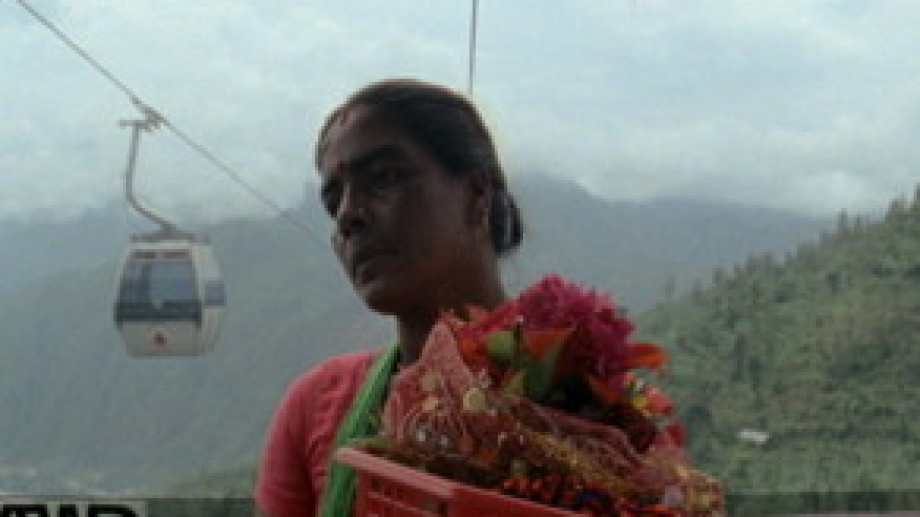
Sometimes the complexities of the trip make the destination all the more worthwhile. Manakamana, the new film from directors Stephanie Spray and Pacho Velez of the famed Harvard Sensory Ethnography Lab (Leviathan, NYFF50), consists of 11 shots in motion: the camera is placed inside a compact cable car, facing different passengers as they ride up and over—and later down—the beautiful foothills of Nepal on their way to the Manakamana Temple. Each shot begins in darkness as the passengers, loaded into the cable car, head toward the beautiful sunlit sights; it’s like waiting in line at your favorite amusement park just before take-off. The ride then begins, the travelers constantly aware of the camera staring back at them.
An interesting collection of men and women (and roosters, cats and goats) take the brief journey suspended in air, the occasional sounds of steel-on-steel making some grimace more than others. Trips occasionally feature a single rider, while others feature up to three passengers. And although the age range of the ridership varies greatly (the opening take is of a young boy and elderly man), most observe and comment on the beauty of the encompassing hills. A few discuss the nearby temple to Hindu Goddess Bhagwati (“Manakamana, we take refuge in you. We worship your power.”) It serves as a soothing, reflexive experience for both the film's subjects and viewers.
Manakamana, which won two new filmmaker awards at the Locarno Film Festival, often feels like a “first person POV,” avant-garde video game—an art installation flawlessly projected in front of us. We’re not necessarily seeing what the passengers see, but rather what’s behind them as they pass over it. The window behind the riders, shaped like a giant television screen, gives the impression that we’re looking at a green screen with the images programmed in afterward. That this is not the case speaks highly of the way the cinematography shapes our experience. The film allows us to look closely at the small details, the facial expressions, the clothes, the melting of an ice cream bar, etc. Some passengers make small talk, while others take photos of themselves or break out their instruments for an impromptu musical session. So much can happen in a single confined space.

Reporting from the Toronto International Film Festival, The Hollywood Reporter noted, “Without any voice-over or editorializing other than camera placement, which is identical in all shots, this is the kind of uncompromising arthouse documentary that festivals will wholeheartedly embrace—indeed, it won several accolades at the recent Locarno Film Festival—but that will remain a tough sell theatrically, though distributors who managed to squeeze some money out of Leviathan might like to see whether lightning can strike twice.”
Mankamana
Directors: Stephanie Spray and Pacho Velez
Section: Motion Portraits (co-presented with Views from the Avant-Garde)
Screens: September 28 at 12:30pm + September 30 at 2:30PM
NYFF Official Description:
Stephanie Spray and Pacho Velez’s (literally) transporting film—shot inside a cable car that carries pilgrims and tourists to and from a mountaintop temple in Nepal—is radically simple in conception. Each of its 11 shots lasts as long as a one-way ride, which corresponds to the duration of a roll of 16 millimeter film. This newest work from Harvard’s Sensory Ethnography Lab—which previously produced Sweetgrass (NYFF '09) and Leviathan (NYFF50)—is thrillingly mysterious in its effects: a staged documentary, a cross between science fiction and ethnography, an airborne version of an Andy Warhol screen test. As with the richest structural films, Manakamana is a kind of head movie that viewers are invited to complete as they watch. Working within a 5-by-5-foot glass and metal box, Spray and Velez have made an endlessly suggestive film that both describes and transcends the bounds of time and space. Winner of the Filmmakers of the Present prize at the 2013 Locarno Film Festival. A Cinema Guild release.



